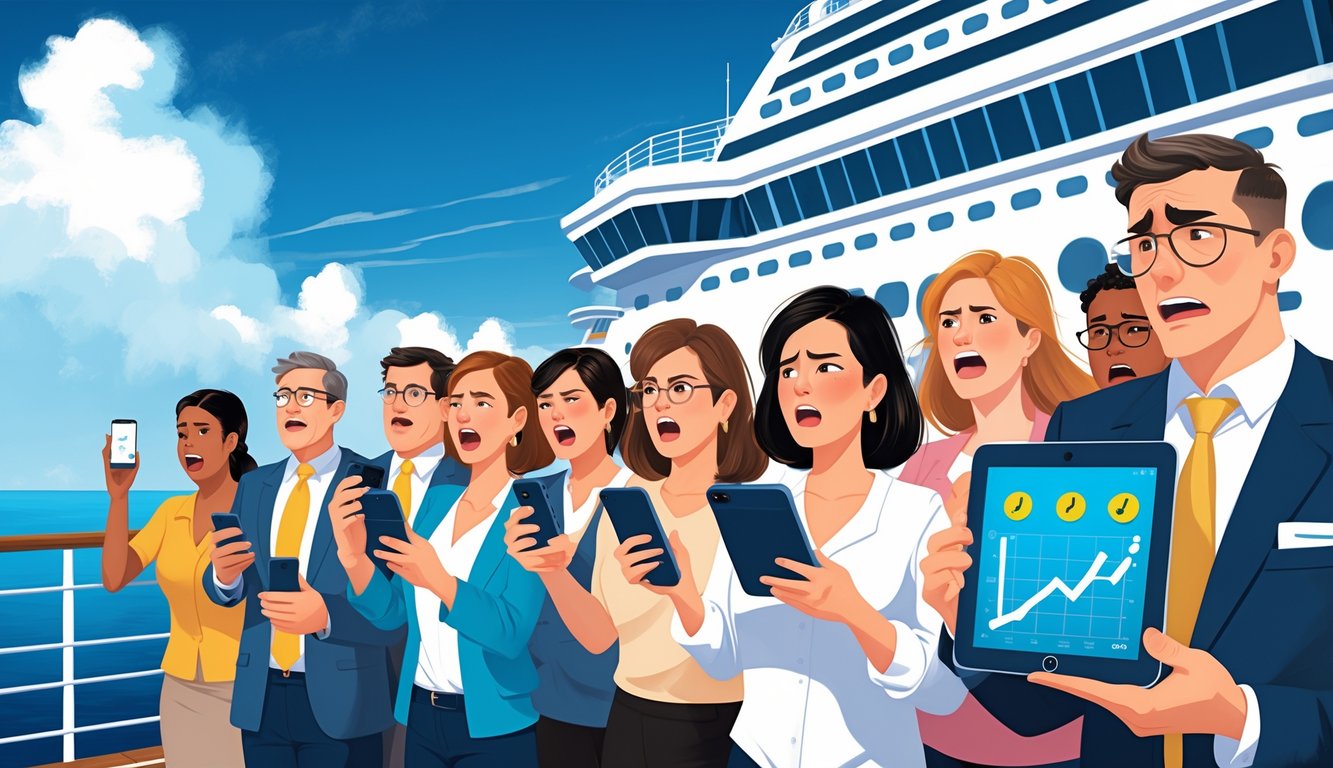
Tips for Navigating New Wi-Fi Pricing on Your Next Sailing
Used to be, getting online at sea wasn’t a wallet-buster. Now? These Wi-Fi surcharges feel like a weird tax on sanity. The gap between basic text-only plans and actual streaming? It’ll nuke your budget before you even notice. I keep wishing I’d compared plans before boarding, but I always forget.
How to Get the Best Value
If you’re anything like me, you see those internet promo emails and think, “I’ll handle it later.” Don’t. Buy Wi-Fi before you board—pre-cruise deals can be 15–20% cheaper. I saw one line offering $16/day pre-cruise, but once I set foot on the ship, it shot up to $22. Annoying doesn’t even cover it.
Some people swear by “messaging only” packages (like $8–10/day), but they never tell you which apps work. Last time, WhatsApp calls worked, Messenger didn’t. Tech guy said the restrictions are “dynamic.” Translation: it’s random.
Frequent cruisers sometimes get free hour blocks or “social” plans, but you have to activate them in person at the help desk, or they vanish. They never put that in the email.
Comparing Plans Before You Sail
Trying to compare plans? Good luck. You’ll end up scrolling forums for hours, trying to figure out if Royal Caribbean’s “VOOM” is actually faster than Norwegian’s “Premium” (spoiler: not really). They all promise “fast speeds,” but CruiseCritic’s speed tests say VOOM averages 4–7 Mbps. Someone on Harmony of the Seas told me Netflix glitches every other hour—try streaming before breakfast.
Why isn’t there just a chart? Look for number of devices, actual Mbps, and video limits. “Streaming enabled” means nothing. I once burned $130 on “full” access, only to learn Instagram videos needed a VPN I couldn’t use. Not convinced guest services even know their own rules.
If you need more than messaging—like Zoom for work—check reviews from this year. GigSky’s guide says Disney and Celebrity are a bit better than Carnival, but basic plans everywhere are still $20+ a day. Screenshot your plan details before you sail. One friend had to prove what was included after a mid-cruise price jump. Screenshots beat arguing in line.
Frequently Asked Questions
I keep staring at my Wi-Fi bill, wondering how the total creeps up faster than a teenager’s phone data. Everyone’s got a story about cruise Wi-Fi blowing up their budget or apps refusing to update for days.
What’s the deal with Wi-Fi access on cruises and why the high fees?
Here’s the thing: it’s all satellites, not fiber. That’s not changing soon—some telecom analyst told me last year. Even junior officers admit bandwidth is tighter than the crew mess at breakfast. My last Princess cruise wanted $24.99/day if you bought ahead.
Then one morning—bam—12% price bump (Carnival, looking at you), no warning. Families lose it. High demand, technical headaches, everyone wants Instagram at sea. Cruise lines aren’t running a charity.
Are there any tips for snagging cheaper or free Wi-Fi while aboard a ship?
Pre-cruise discounts in the fine print are your best shot. Once you’re on board, prices jump—sometimes by $2+ per day. Carnival? $23.80 if you buy before, $28 if you wait. Loyalty perks exist (Princess gives elites 50% off, but I’m stuck at bronze forever). Sometimes there are bundles with drink packages, but it’s a maze.
One bartender swore you can catch a weak signal near the terminal in port, but security doesn’t love loiterers. My cousin keeps asking about “employee override codes” at the front desk. Never works, but it’s entertaining.
Is there a way to use the internet on a cruise ship without breaking the bank?
You’d think a metered plan would help, but most lines ditched “pay-as-you-go” for unlimited daily rates. Someone told me if you log in just for email and then actually log off (not just close your browser), you can stretch a one-device plan for a family—assuming nobody sneaks TikTok.
Some cell carriers (T-Mobile, AT&T) offer “cruise” passes, but the fine print says “may incur satellite fees.” Uh, what? Stack SIM cards? Maybe.
Why has there been a recent spike in Wi-Fi costs for cruise passengers?
No warning. One morning, 12% hike. Carnival tech folks said everyone tried streaming 4K Netflix during peak season, so they “optimized” bandwidth (a.k.a., jacked up prices and throttled speeds).
Satellite bandwidth isn’t getting cheaper, and these ships keep adding apps—facial recognition, mobile keycards, digital menus. Yet Wi-Fi is still a “luxury.” Reminds me of hotels charging for in-room coffee and calling it premium.
How can I stay connected at sea without incurring massive Wi-Fi charges?
Still haven’t figured out why my local library’s Wi-Fi beats a $300/night cabin. I just use airplane mode and wait for port days—everyone mobs the pier café for free land internet. If you’re desperate, use apps that compress data (WhatsApp, not FaceTime).
Sometimes the “free social media” plan is so throttled you’d be better off sending a postcard. Not a solution, just reality. Honestly, packing a waterproof phone pouch was the smartest thing I did—at least I didn’t ruin my phone by the pool.
What alternatives do I have to cruise ship Wi-Fi that won’t cost me an arm and a leg?
So, I tried renting one of those mobile hotspots—GigSky, with the global SIM and all that jazz. It actually worked for like five minutes in the Bahamas, but then, poof, nothing but frustration the second we drifted out to sea. Caribbean? Forget it. Local SIM cards? Sure, if your phone’s unlocked and you’re up for haggling with kiosk people who might or might not speak your language, and honestly, who has the energy for that after a red-eye flight?
I just download maps and a pile of Netflix before I leave. Airplane mode’s my safety blanket. No surprise fees, no stress. My brother keeps pushing satellite messengers for “emergencies.” I don’t know, maybe he’s prepping for the apocalypse? I’d rather just hit up a coffee shop in port and use their sketchy Wi-Fi. And, honestly, how many different charging cables am I supposed to pack? Why does every gadget need its own weird charger? I swear, keeping track of cords is harder than dodging Wi-Fi fees.



